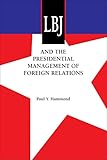LBJ and the Presidential Management of Foreign Relations / Paul Y. Hammond.
Material type: TextSeries: An Administrative History of the Johnson PresidencyPublisher: Austin : University of Texas Press, [2021]Copyright date: ©1993Description: 1 online resource (312 p.)Content type:
TextSeries: An Administrative History of the Johnson PresidencyPublisher: Austin : University of Texas Press, [2021]Copyright date: ©1993Description: 1 online resource (312 p.)Content type: - 9780292773134
- 973.923092
- online - DeGruyter
| Item type | Current library | Call number | URL | Status | Notes | Barcode | |
|---|---|---|---|---|---|---|---|
 eBook
eBook
|
Biblioteca "Angelicum" Pont. Univ. S.Tommaso d'Aquino Nuvola online | online - DeGruyter (Browse shelf(Opens below)) | Online access | Not for loan (Accesso limitato) | Accesso per gli utenti autorizzati / Access for authorized users | (dgr)9780292773134 |
Frontmatter -- Contents -- Foreword -- Preface. Where We Are Going: Presidential Management and the External Presidency -- Acknowledgments -- 1. Johnson's Foreign Relations: Toward a Broader Inquiry -- 2. The Larger Vision of Foreign Policy Management -- 3.1 The Indian Famine and Presidential Leverage -- 4. Johnson and Europe: The MLF and Alliance Politics -- 5. Influence, Strategy, and Western Europe -- 6. Vietnam: Normality and Innovation -- 7. Johnson's Foreign Policy Leadership in Larger Perspective -- Notes -- Bibliography -- Index
restricted access online access with authorization star
http://purl.org/coar/access_right/c_16ec
In this insightful study, Paul Y. Hammond, an experienced analyst of bureaucratic politics, adapts and extends that approach to explain and evaluate the Johnson administration’s performance in foreign relations in terms that have implications for the post–Cold War era. The book is structured around three case studies of Johnson’s foreign policy decision making. The first study examines economic and political development. It explores the way Johnson handled the provision of economic and food assistance to India during a crisis in India’s food policies. This analysis provides lessons not only for dealing with African famine in later years but also for assisting Eastern Europe and the former Soviet Union. The second case study focuses on U.S. relations with Western Europe at a time that seemed to require a major change in the NATO alliance. Here, Hammond illuminates the process of policy innovation, particularly the costs of changing well-established policies that embody an elaborate network of established interests. The third case study treats the Vietnam War, with special emphasis on how Johnson decided what to do about Vietnam. Hammond critiques the rich scholarship available on Johnson’s advisory process, based on his own reading of the original sources. These case studies are set in a larger context of applied theory that deals more generally with presidential management of foreign relations, examining a president’s potential for influence on the one hand and the constraints on his or her capacity to control and persuade on the other. It will be important reading for all scholars and policymakers interested in the limits and possibilities of presidential power in the post–Cold War era.
Mode of access: Internet via World Wide Web.
In English.
Description based on online resource; title from PDF title page (publisher's Web site, viewed 26. Apr 2022)


